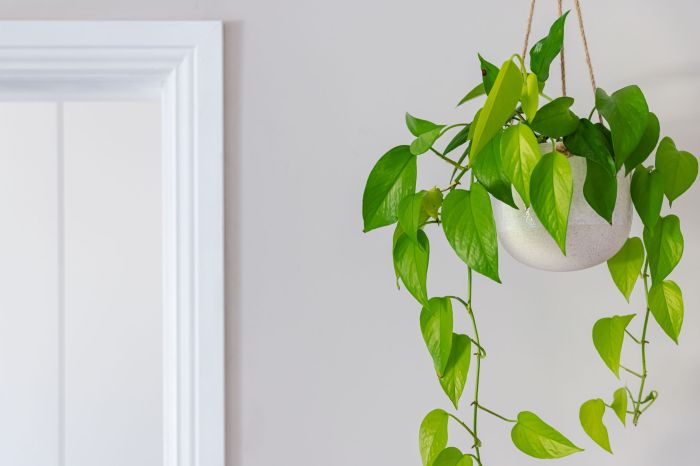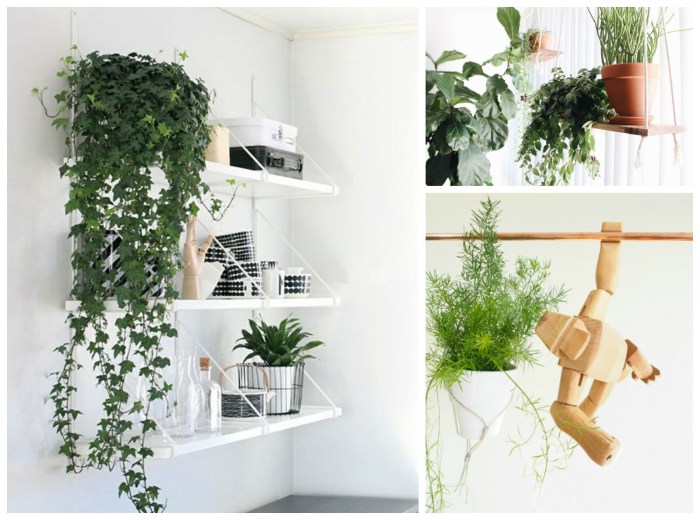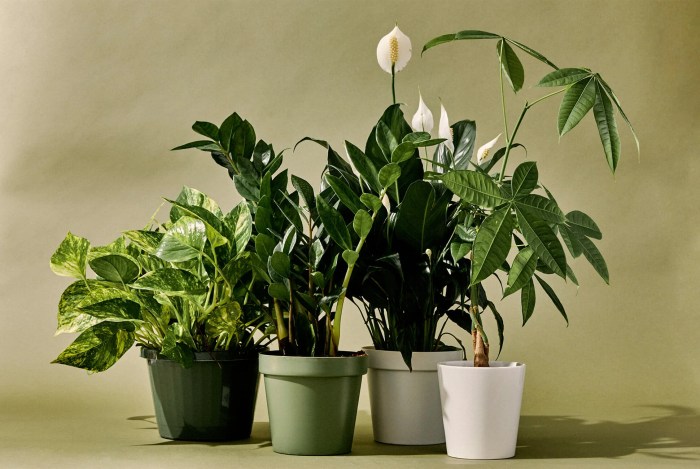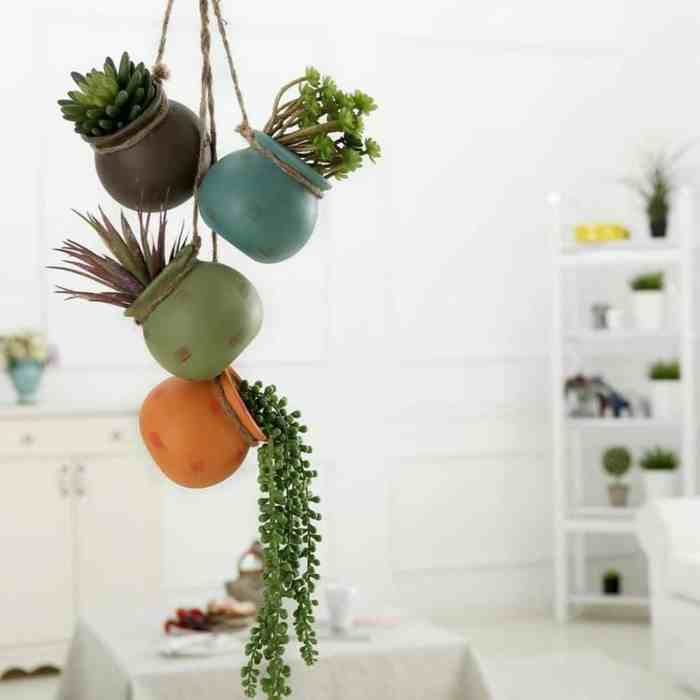Best indoor plants to hang are a stylish and practical way to add life and color to your home. From trailing vines to lush ferns, these plants can purify the air, reduce stress, and elevate any room’s aesthetics.
In this comprehensive guide, we’ll explore the most popular hanging plants, discuss their benefits, provide care tips, and offer creative design ideas to help you create a beautiful and thriving indoor oasis.
Popular Hanging Plants

Hanging plants are a great way to add greenery to your home without taking up too much space. They can be used to create a focal point in a room, or to add a touch of color and life to a corner.
There are many different types of hanging plants to choose from, each with its own unique look and care requirements.
Here are some of the most popular indoor hanging plants:
| Plant Name | Description | Care Requirements |
|---|---|---|
| Spider Plant | A popular choice for beginners, spider plants are easy to care for and produce long, trailing stems with variegated leaves. | Prefers bright indirect light and well-draining soil. Water when the top inch of soil is dry to the touch. |
| Pothos | Another easy-care plant, pothos is known for its heart-shaped leaves that come in a variety of colors. | Tolerates low light conditions and prefers well-draining soil. Water when the top 2 inches of soil are dry to the touch. |
| String of Pearls | A unique and eye-catching plant, string of pearls features long, trailing stems with small, bead-like leaves. | Prefers bright indirect light and well-draining soil. Water sparingly, allowing the soil to dry out completely between waterings. |
| Burro’s Tail | A succulent with plump, fleshy leaves that resemble a donkey’s tail, burro’s tail is a popular choice for hanging baskets. | Prefers bright indirect light and well-draining soil. Water sparingly, allowing the soil to dry out completely between waterings. |
| Hoya Carnosa | Also known as the wax plant, hoya carnosa is a popular choice for hanging baskets due to its trailing stems and clusters of star-shaped flowers. | Prefers bright indirect light and well-draining soil. Water when the top inch of soil is dry to the touch. |
Benefits of Hanging Plants

Hanging plants are not only a beautiful addition to any home, but they also offer a number of benefits for your health and well-being.
Studies have shown that hanging plants can improve air quality by removing toxins from the air. One study, published in the journal Environmental Science & Technology, found that hanging plants can remove up to 85% of formaldehyde from the air.
Formaldehyde is a known carcinogen that is found in many household products, such as carpets, furniture, and cleaning supplies.
Hanging plants can also help to reduce stress. A study, published in the journal HortScience, found that people who spent time in a room with hanging plants had lower levels of cortisol, a hormone that is associated with stress.
Hanging plants add a touch of greenery and life to any indoor space. Some of the best indoor plants to hang include those that have trailing or cascading growth habits. For a stunning display, consider the best cascading house plants such as pothos, spider plants, and string of pearls.
These plants will add a lush, vertical element to your home décor while purifying the air.
In addition to improving air quality and reducing stress, hanging plants can also add a touch of beauty to any home. They can be used to create a focal point in a room, or to add a touch of greenery to a dull corner.
Improved Air Quality
- Hanging plants can remove toxins from the air, such as formaldehyde, benzene, and trichloroethylene.
- These toxins are found in many household products, such as carpets, furniture, and cleaning supplies.
- Studies have shown that hanging plants can remove up to 85% of formaldehyde from the air.
Reduced Stress
- Hanging plants can help to reduce stress levels.
- A study, published in the journal HortScience, found that people who spent time in a room with hanging plants had lower levels of cortisol, a hormone that is associated with stress.
- The presence of plants in a room can create a sense of calm and relaxation.
Increased Aesthetics
- Hanging plants can add a touch of beauty to any home.
- They can be used to create a focal point in a room, or to add a touch of greenery to a dull corner.
- Hanging plants come in a variety of shapes, sizes, and colors, so you can find one that fits your style and decor.
Plant Care Considerations

Maintaining healthy hanging plants requires proper care tailored to their specific needs. This includes providing adequate watering, lighting, and fertilization, with adjustments based on plant type and environmental conditions.
Regular watering is crucial for hanging plants, as they may dry out more quickly due to their elevated position. However, overwatering should be avoided to prevent root rot. Allow the soil to dry out slightly between waterings, and adjust the frequency based on the plant’s water requirements and the ambient humidity.
Lighting, Best indoor plants to hang
Hanging plants have varying light requirements. Some, like ferns and pothos, thrive in low light conditions, while others, such as succulents and orchids, prefer brighter light. Determine the appropriate light level for each plant and provide it with the necessary exposure.
Avoid placing plants in direct sunlight, as this can scorch the leaves.
Hanging plants can add a touch of greenery and freshness to any indoor space. Whether you’re looking for plants that can tolerate low light or thrive in bright, sunny conditions, there are plenty of options to choose from. For areas with high light, consider best hanging plants for high light such as spider plants, pothos, and philodendrons.
These plants will not only add a pop of color to your space but also purify the air and improve overall well-being.
Fertilization
Fertilizing hanging plants regularly provides them with essential nutrients. Use a balanced fertilizer diluted to half strength and apply it during the growing season. Avoid overfertilizing, as this can damage the plant’s roots.
Design Ideas for Hanging Plants
Incorporating hanging plants into interior design adds a touch of nature and freshness to any space. They offer creative opportunities to enhance room aesthetics and bring a sense of tranquility indoors.
Hanging from the Ceiling
Hanging plants from the ceiling creates a dramatic focal point. Use large, trailing plants like pothos or spider plants to create a lush canopy effect. Suspend multiple plants at different heights to add depth and interest.
Hanging plants can add a touch of greenery and freshness to any indoor space. Among the best indoor plants to hang, succulents stand out for their low-maintenance nature and ability to thrive in a variety of environments. For those looking for the best indoor hanging succulents, a variety of options are available, including String of Pearls , Burro’s Tail , and Sedum Morganianum . These succulents are known for their trailing stems, which can create a beautiful cascading effect when hung from a ceiling or shelf.
Additionally, they require minimal watering and can tolerate low light conditions, making them ideal for busy individuals or those with limited sunlight.
Wall-Mounted Planters
Wall-mounted planters are a space-saving solution that adds a touch of greenery to bare walls. Choose planters in various shapes and sizes to create a dynamic display. Consider using macrame or leather hangers for a bohemian touch.
Shelving Arrangements
Hanging plants on shelves adds height and dimension to a room. Group plants of different sizes and colors to create a visually appealing arrangement. Use floating shelves or hanging planters to showcase your collection.
Enhancing Different Room Styles
Hanging plants can complement various room styles:
- Bohemian:Use macrame hangers and trailing plants like ivy or ferns.
- Modern:Opt for geometric planters and succulents or air plants.
- Scandinavian:Choose minimalist planters and plants with clean lines, such as snake plants or ZZ plants.
- Traditional:Use classic hanging baskets and trailing plants like begonias or petunias.
Troubleshooting Common Issues

Hanging plants, while beautiful and space-saving, can sometimes face specific challenges. Understanding and addressing these issues is crucial for maintaining healthy and thriving indoor greenery.
Common Problems and Solutions
- Yellowing Leaves:Yellowing leaves can indicate overwatering, underwatering, nutrient deficiency, or pest infestation. Check the soil moisture and adjust watering frequency accordingly. Fertilize regularly to ensure adequate nutrients. Inspect for pests and treat as necessary.
- Pests:Aphids, mealybugs, and spider mites are common pests that can affect hanging plants. Use insecticidal soap or neem oil to control infestations. Regularly check plants for pests and isolate affected ones to prevent spread.
- Overwatering:Overwatering can lead to root rot and yellowing leaves. Allow the soil to dry out between waterings and avoid leaving plants in waterlogged pots. Use a well-draining potting mix and ensure drainage holes are unobstructed.
- Underwatering:Underwatered plants may have wilted leaves and dry soil. Water thoroughly until water drains from the drainage holes. Monitor soil moisture and water when the top inch of soil feels dry to the touch.
- Lack of Sunlight:Hanging plants may not receive enough sunlight if placed too far from a window. Move plants closer to a light source or consider using grow lights to supplement natural light.
Conclusive Thoughts

Hanging plants are not only visually appealing but also beneficial for your health and well-being. Whether you’re looking to add a touch of greenery to a small apartment or create a lush indoor jungle, these plants are a perfect choice.
With proper care and creativity, you can enjoy the beauty and benefits of hanging plants for years to come.
FAQ Section: Best Indoor Plants To Hang
What are the most popular hanging plants?
Some of the most popular hanging plants include pothos, spider plants, ferns, philodendrons, and string of pearls.
How do hanging plants benefit indoor air quality?
Hanging plants help purify the air by removing harmful toxins and pollutants.
How often should I water hanging plants?
The frequency of watering depends on the type of plant, but most hanging plants require watering once or twice a week.